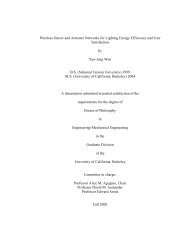Insulation
Insulation
Insulation
You also want an ePaper? Increase the reach of your titles
YUMPU automatically turns print PDFs into web optimized ePapers that Google loves.
greater resistance to air and water vapor flows. Because the closed-cell foam is denser it<br />
requires more material and thus expenses. Closed-cell foam is recommended for use over<br />
open-cell below grade, especially in conditions of high water tables.<br />
Spray polyurethane foam seals the entire building envelope of the home to prevent air<br />
and moisture infiltration. Specifically polyurethane maintains a permanent shape and will<br />
not sag or deform. In addition, it adds strength to the building structure. Lateral<br />
movement by strong winds and storms create shearing forces on the home. Foam<br />
insulation is monolithic and capable of reducing racking and shearing. Closed-cell spray<br />
foam reinforces rigidity of the studs and sheathing.<br />
In terms of installation and application, the foam is formed by trapping many gas forms<br />
into a liquid or solid. One of the most popular foam insulations is polyurethane. It<br />
contains polyol (a petroleum product), a surfactant, and a catalyst (to control reaction<br />
rate). The size of the bubbles differs based on reaction rate and it dictates the density of<br />
the foam product. Roofing foam must be denser than wall foam for higher strength. The<br />
bubbles come from a blowing agent which is a liquid with a low boiling point, which is<br />
capable of producing pockets of a gas. The last ingredient is isocyanate, which is highly<br />
reactive. Isocyanate is separated from all components until dispensed through the hose<br />
gun. Once it hits the substrate it drives the expansion reaction very quickly. Spray foam<br />
insulation is applied to walls with an 80% pass. A downside to spray foam insulation is it<br />
requires a skilled installer to prevent overspray.<br />
Spray polyurethane foam has an R-value of approximately 6.0-7.0 per inch, depending on<br />
formulation. This R-value is significantly higher than glass fiber, wool, and cellulose<br />
insulations. It is adequate for residential, commercial, and industrial buildings. Spray<br />
Polyurethane Foam provides more thermal resistance with less material than any other<br />
commercial insulation material. It has a fairly low sound transmission coefficient of 37.<br />
Spray polyurethane foam costs roughly $1.25-$2.25 per square foot. It forms to walls,<br />
floors, and roofs as a tight seal, stopping air leakage as well as moisture infiltration.<br />
Traditional fiberglass insulation stapled or placed into wall cavities does not seal the stud<br />
and wall cavities, and gaps remain. For homes with crawl spaces and basements, high<br />
humidity brings trouble for standard fiberglass insulation. Fiberglass absorbs moisture; it<br />
may get heavy and fall from sub-flooring. Spray foam contractors are often hired to<br />
remove old and wet fiberglass, and use spray foam as replacement. Spray foam maintains<br />
its physical properties over time.<br />
Oftentimes, no additional vapor barrier is required when using Spray Polyurethane Foam,<br />
saving an additional item cost. Performance studies in the field suggest Spray<br />
Polyurethane Foam systems used for roofing can last thirty or more years. Walls have a<br />
longer lifetime exists due to its lack of exposure. Spray foam insulation increases a<br />
home’s energy performance, structural integrity and air quality; and is increasingly used<br />
to insulate walls, basements, and attics of homes.<br />
Hurricane Katrina destroyed the original roof of the Superdome in New Orleans and<br />
caused $250 million in damages to the structure. The state of Louisiana demanded a roof
















